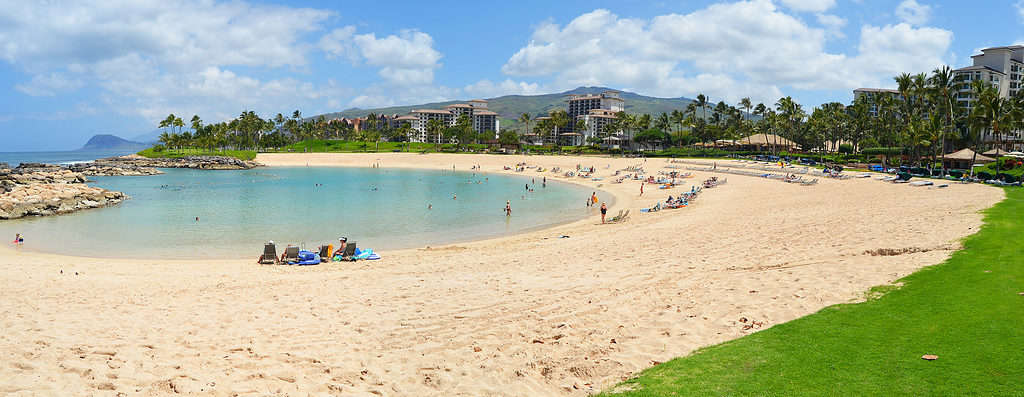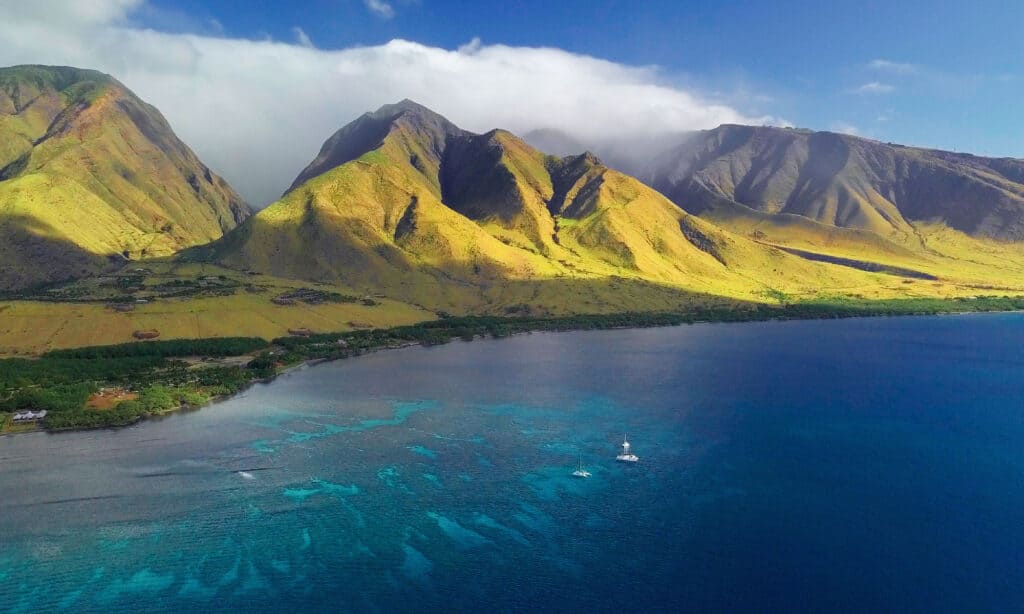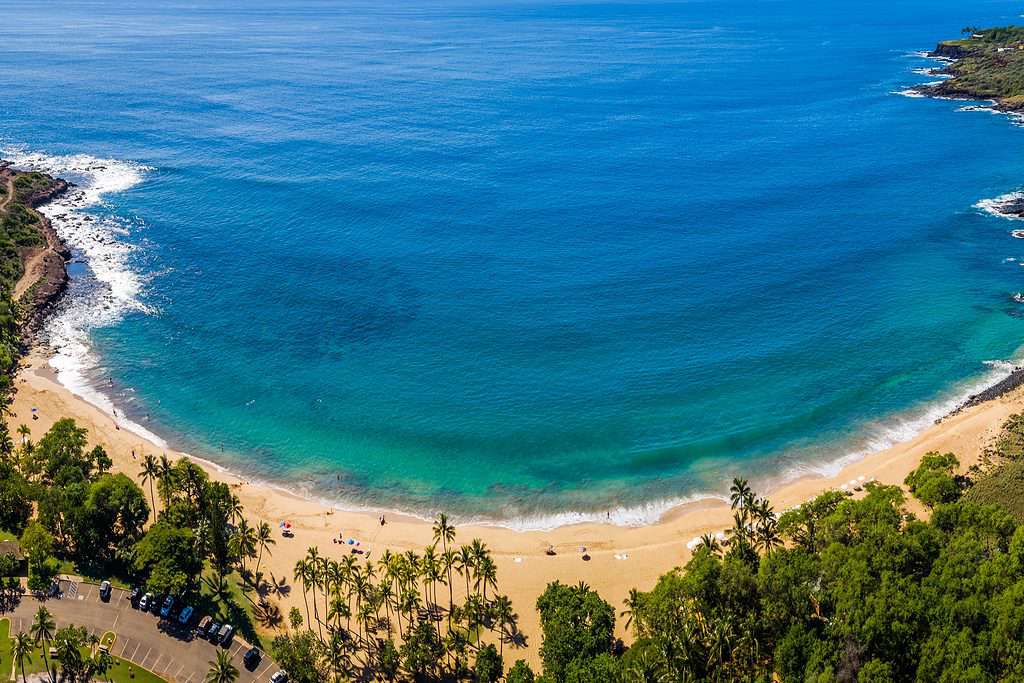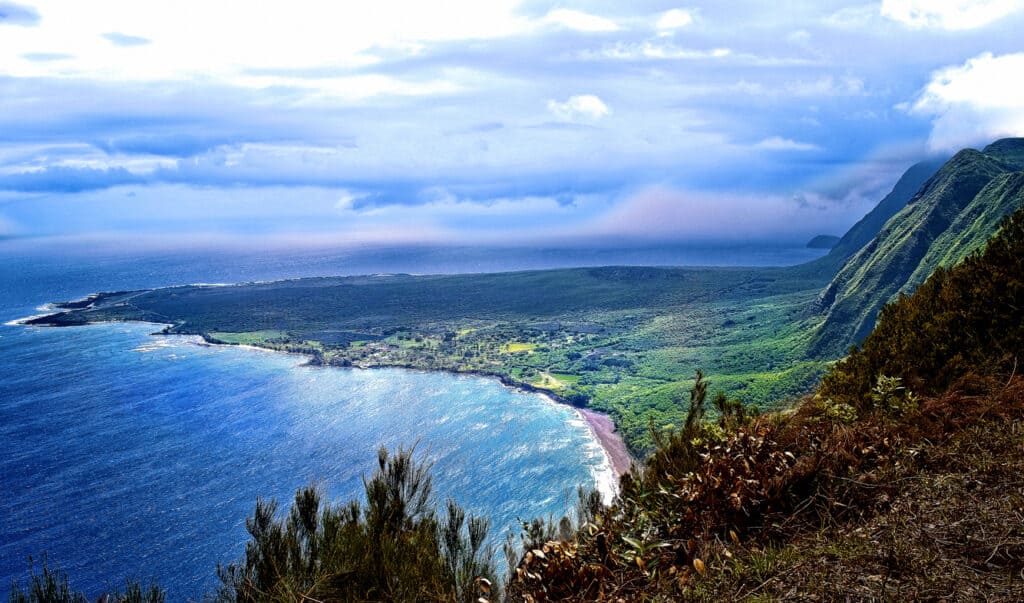A day spent swimming off a beach in Hawaii is a day well spent. In fact, beaches are almost synonymous with Hawaii, along with pristine clear waters and perfect temperatures. Whether you’re a resident or vacationing in the tropical state, there’s a beach for all people and a variety of moods. There are calm beaches for swimming and relaxing, and others with big waves for adventurous surfers. Hike down to a hidden, near isolated beach or join the crowds on popular stretches of sand.
You can easily find stunning waters and breathtaking views at the top of every “Best of Hawaii” list. The Aloha Islands have more than enough natural beauty and recreational water activities to feed your wanderlust.
Hawaii is a year-round holiday hotspot. However, visit during particular months to enjoy your trip to the fullest. The sea temperature in the summer averages 82 °F (27.8 °C); smaller waves, sunny skies, and warmer waters make it the perfect time for swimming and snorkeling.
#1 Hanalei Bay

Hanalei Beach in Kauai features a vast expanse of fine sand and still, calm waters, with towering mountains as a backdrop.
©Kelsey Neukum/Shutterstock.com
Crescent-shaped Hanalei Bay is Kauai’s most prominent swim-friendly location, with a length of about two miles and a width of 125 feet. It extends from Princeville’s border with the Hanalei River on the east to the Waipa Stream on the west.
This relaxing bay features a vast expanse of fine sand and still, calm waters. With towering mountains as the backdrop, we can only imagine the postcard-worthy pictures you could snap.
Black Pot Beach, Waioli Beach Park, and Hanalei Beach Park are the three separate beaches that makeup Hanalei Bay. Most areas have swim-friendly conditions. In fact, Hanalei Bay is known for its great family-friendly beaches. When there’s no surf, the beach’s gentle slope into the water creates a great play area for young children learning to swim. Adult swimmers can explore the long stretch of water without fighting waves.
Once you’ve had your fill of the beach, take a stroll around the quaint town of Hanalei. This charming town has shops, food trucks, smoothie joints, and art galleries waiting to be explored. And after a full day of snorkeling in the sun, Holey Grail’s taro donuts are not to be missed!
Parking can be difficult during the weekends, but there are three parking lots for those who want to drive to the beach. The first parking space is located on the left side of Highway 56, immediately after Nualolo Road. The second parking lot stretches close to the Hanalei Pier on the right side of the same highway. The third parking spot is within Black Pot Beach Park, which also has picnic tables, outdoor showers, and public restrooms. Alternatively, street parking is free in Hanalei, if you’re okay with walking down to the beach.
#2 Ko Olina Lagoons

The four lagoons of Ko Olina are separated by a short trek and are accessible to the general public, despite being a privately owned facility.
©Andmir/Shutterstock.com
You can find the 642-acre Ko Olina Lagoons on the west coast of Oahu, connected by over 1.5 miles of seashore walkways. The four lagoons of Ko Olina are separated by a short trek and are accessible to the general public, despite being a privately owned facility.
With its reef-protected shallow turquoise waters and rock levies as sea walls, the lagoons provide safe swimming for all members of the family. The levies keep choppy waves out of the lagoons, allowing the water to gently lap the beach. Kids can splash around, while adults lap swim. However, Ko Olina does not have amenities or lifeguards, so bring everything you need and be careful in the water.
Daily public parking is offered in designated spaces from sunrise to sunset on a first-come, first-served basis.
#3 Kua Bay

The crystal blue waters and black lava rocks of Kua Bay contribute to its contrasting natural beauty.
©Danne_I/Shutterstock.com
Kua Bay is a secluded white sand beach officially known as Manini’owali Beach. It’s located on the northern end of the Kekaha Kai State Park and on the west coast of the Big Island.
The crystal blue waters and black lava rocks from a volcano contribute to its contrasting natural beauty, an idyllic setting for a sunny afternoon at the beach. It’s the perfect spot for swimming, bodyboarding, and snorkeling in the summer when the waves are calm. However, it’s prone to big waves and powerful currents in the winter.
There are a few food trucks in the parking area; or bring your own food and drinks for a picnic! Turtles and dolphins can be spotted near the shore on calm days.
Come ready with your beach-appropriate footwear and reef-safe sunscreen. Be prepared to navigate about three meters of lava rocks before getting to the sand. Also, bring an umbrella or a hat because the beach has no shade. There are public showers and restrooms in the parking lot.
Take the paved 1.5-mile road from the main highway until you reach the parking area. Vehicles are often parked along the last section of the road because the lot quickly fills up on weekends. Therefore, weekdays are best for visiting Kua Bay due to the congestion you may encounter otherwise.
#4 Kā‘anapali Beach

Maui, pictured here, has many lovely spots, including Kā‘anapali Beach.
©iStock.com/mihtiander
This is one of the most popular beaches in west Maui and all of Hawaii. In fact, it was named America’s Best Beach in 2003. The three-mile-long, gorgeous beach is large enough to accommodate the crowd it draws, despite being fronted by multiple high-end resorts.
Kā‘anapali Beach was originally a haven for Maui’s monarchy and it was later the location of the first planned resort in the Aloha State. Today, it’s a renowned vacation destination where swimming and snorkeling are popular during the summer months. You can also go ziplining for a spectacular view of the stunning coastline.
What’s a trip to Kā‘anapali Beach without experiencing the daily cliff diving ceremony? Brave visitors dive off the 16-foot Puʻu Kekaʻa or Black Rock on the beach’s northern end every evening at sunset in recognition of Maui’s legendary King Kahekili. Watch as cliff divers prepare by lighting torches along the rocks before jumping.
The open-air Whalers Village, a prime retail center with an array of stores, restaurants, and a whaling museum, is another top attraction at Kā‘anapali Beach.
#5 Hulopoʻe Bay

Visitors must leave every shell in its proper place on this Lanai beach because the protected area is home to an abundance of sea creatures.
©Russell deJetley/Shutterstock.com
The breathtaking white sand beach of Hulopoʻe Bay on the southern shore of Lanai is the island’s signature beach. It’s no wonder this protected natural beauty earned the title of America’s Best Beach in 1997.
Lanai is the smallest of the six inhabited Hawaiian Islands accessible to the general public. It’s also known as Pineapple Island because it used to have a pineapple plantation.
Hulopoʻe Bay fronts the exotic Four Seasons Resort and is unarguably the best swimming spot on Lanai Island for most of the year. Swimming is delightful during the summer because of the calm waters. However, it’s not recommended during winter due to the choppy conditions.
Polihua beach on the northern coast is one of Hawaii’s longest white sand beaches. But its strong winds and occasionally dangerous surf make it more suited for beachcombing than swimming.
The public can use Hulopoe Beach Park, which also features picnic tables, showers, grills, and restrooms.
Large tide pools on the eastern side of Hulopoe Bay are among its attractions. These tidal pools, made of volcanic rock, are well-protected, and the waters are calm, making them ideal for exploration.
Visitors must leave every stone and shell in its proper location because the area is protected and homes an abundance of sea creatures. For example, Hulopoe Bay is frequently visited by spinner dolphins, and humpback whales migrate here throughout the winter.
#6 Waimea Bay Beach Park

The azure blue summer waters of Waimea Bay are perfect for swimming, boogie boarding, snorkeling, and fishing.
©Kelly Headrick/Shutterstock.com
The optimum season to swim in Waimea Bay Beach Park is summer. While summer waters are pleasant, the park is known for receiving 30-foot waves in winter. These conditions draw some of the best surfers in the world, but tourists should never swim here outside of the summer months.
The azure blue summer waters of Waimea Bay are perfect for swimming, boogie boarding, snorkeling, and fishing. The park is equipped with every amenity imaginable, including parking, picnic spots, lifeguards, restrooms, and showers.
You can’t miss Waimea Bay; a big steep-sided rock fragment called “The Rock” sits at the water’s edge. Adventurous swimmers love jumping from various heights into the blue ocean below. Note that it can be hazardous to leap off the rock, and many people have been injured here. So please pay attention to the numerous posted notices and respect their caution.
#7 Kapukahehu Beach

The beaches in Molokai, like Kapukahehu, should be at the top of your list if you’re looking for a calm, crowd-free beach.
©iStock.com/John Richard Stephens
Kapukahehu on Molokai Island is often referred to as Dixie Maru Beach. It’s a small, secluded cove with golden sand and calm waters best for swimming. This spot is a family favorite! However, caution is advised because the beach lacks lifeguards, and high surf days may bring strong currents. Always check the surf report before swimming.
The beaches in Molokai should be at the top of your list if you’re looking for a calm, crowd-free beach. You’ll experience unspoiled quiet sands away from the congestion associated with resorts.
Swimming Holes in Hawaii
Swimming holes are an unusual choice in the beach-filled state of Hawaii, but they can offer thrilling swims, beautiful views, and a unique swimming experience.
Although Hawaii has some of the most beautiful beaches in the world, there are times when you want something a little more “off the beaten path.” There are many out of the way places where you can take a dip amidst breathtaking scenery.
Makaleha Falls in Kauai, Makapu’u Tide Pools in Oahu, Pe’epe’e Falls in Big Island, O’heo Gulch, and Pua’a Ka’a State Wayside in Maui top the list of options when you’re planning an outdoor adventure in the Aloha State.
Lakes in Hawaii
There are just five naturally occurring lakes in Hawaii, and they are all relatively small, according to the Division of Aquatic Resources of the State of Hawaii. However, stream waters have been impounded to form 266 freshwater reservoirs with sizes of up to 400 surface acres. Lake Waiau, Hālaliʻi Lake, Halulu Lake, Violet Lake, and Laysan Lake are the five natural Hawaiian lakes. Together, these water bodies serve as habitats for numerous fish and wetland bird species.
Rivers for Floating
The Hawaiian Islands have just a few rivers, only one of which can be crossed by boats bigger than kayaks. But they are all the perfect size for a leisurely kayak trip or for taking a tranquil float.
At Flumin’ Kohala on the northern tip of Hawaii Island, you can paddle and coast in four-person inflatable kayaks down three miles of the old irrigation ditch. Pass through 1,000-foot tunnels flowing with spring water, float over rushing streams, and cross the slope via raised flumes.
Beaches
Hawaiian beaches exist in a variety of sizes and colors. Remarkable features are big Island’s volcanic rock terrain and a few famous white-sand beaches. Visit Oahu for the best surfing and Kauai for snorkeling and marine life exploration.
Some of the most remote and undeveloped beaches are on Molokai, while Lanai Island beaches offer acrobatic displays of spinner dolphins. In essence, there’s no shortage of different types of beaches in Hawaii.
Water Parks
You might assume that Hawaii would be teeming with water and amusement parks, given that it is a well-known tourist destination, but most islands don’t have a sizable water park. Of course, for most visitors, this is a non-issue. Afterall, Hawaii is full to the brim of its own natural “water parks” in the form of waterfalls, lagoons, and beaches.
However, if you’re determined to experience a traditional waterpark in Hawaii, check out Wet ‘n’ Wild Hawaii on Oahu Island. It’s the only major water park in the state and offers a decent selection of activities, including mat-racing slides, a funnel ride, a family raft ride, a large wave pool, and a themed lazy river. In addition, a spray ground and an interactive water play area are available for kids.
Summary Of The Best Swimming Spots In Hawaii
| Rank | Swimming Spot | Location |
|---|---|---|
| 1 | Hanalei Bay | Kauai |
| 2 | Ko Olina Lagoons | West Oahu |
| 3 | Kua Bay – Manini’owali Beach | Big Island |
| 4 | Kā‘anapali Beach | West Maui |
| 5 | Hulopoʻe Bay | Lanai |
| 6 | Waimea Bay Beach Park | Haleiwa, Oahu |
| 7 | Kapukahehu Beach | Molokai Island |
The photo featured at the top of this post is © Pierre Leclerc/Shutterstock.com
Thank you for reading! Have some feedback for us? Contact the AZ Animals editorial team.






